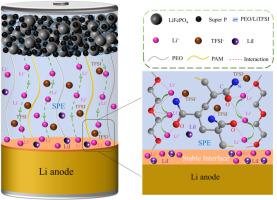Electrochimica Acta ( IF 5.5 ) Pub Date : 2023-02-17 , DOI: 10.1016/j.electacta.2023.142062 Xurui Li , Shuai Liu , Jing Shi , Minghua Huang , Zhicheng Shi , Huanlei Wang , Zhenhua Yan

|
Solid polymer electrolyte (SPE) as core component of all-solid-state lithium metal battery (ASSLMB) has regained tremendous concerns due to its good flexibility and low cost. However, low ionic conductivity, unstable interphase and unsatisfying cycling stability hinder its practical application in ASSLMB. Herein, we designed a PEO-based SPE (PEO/20PAM/LiI) via adding optimum content of poly (acrylamide) (PAM) and 2 wt% LiI to address above issues. The amide groups (-(C = O)-(N H)) in PAM could effectively facilitate the decomposition of LiTFSI due to the strong coordination of C = O/Li+ and N
H)) in PAM could effectively facilitate the decomposition of LiTFSI due to the strong coordination of C = O/Li+ and N H/TFSI−, significantly releasing more “Free Li+”. The C = O group also weakens the coordination of Li+/ether oxygen and assists Li+ transfer along the PEO chains, providing an efficient transmission pathway for Li+. Furthermore, LiI could facilitate the uniform Li+deposition at the electrode-electrolyte interface and stimulate the formation of stable interfacial layer, restraining the generation of lithium dendrites. The obtained PEO/20PAM/LiI exhibits high ionic conductivity (2.75 × 10−4 S cm−1, 35 °C), outstanding mechanical strength (0.55 MPa) and wide electrochemical window (∼ 5 V). The assembled Li symmetric battery could endure high critical current density (CCD, 1.8 mA cm−2) and perform Li plating/stripping steadily over 1600 h at 0.1 mA cm−2 at 35 °C. Meanwhile, LiFePO4 (LFP)/Li ASSLMB with this SPE displays preeminent cycling stability over 250 cycles with high capacity retention (97.3%) and high coulombic efficiency (99.9%) at 0.3 C at 35 °C. This rational design strategy shows great potential in simultaneously realizing high ionic conductivity and good interfacial stability for ASSLMB.
H/TFSI−, significantly releasing more “Free Li+”. The C = O group also weakens the coordination of Li+/ether oxygen and assists Li+ transfer along the PEO chains, providing an efficient transmission pathway for Li+. Furthermore, LiI could facilitate the uniform Li+deposition at the electrode-electrolyte interface and stimulate the formation of stable interfacial layer, restraining the generation of lithium dendrites. The obtained PEO/20PAM/LiI exhibits high ionic conductivity (2.75 × 10−4 S cm−1, 35 °C), outstanding mechanical strength (0.55 MPa) and wide electrochemical window (∼ 5 V). The assembled Li symmetric battery could endure high critical current density (CCD, 1.8 mA cm−2) and perform Li plating/stripping steadily over 1600 h at 0.1 mA cm−2 at 35 °C. Meanwhile, LiFePO4 (LFP)/Li ASSLMB with this SPE displays preeminent cycling stability over 250 cycles with high capacity retention (97.3%) and high coulombic efficiency (99.9%) at 0.3 C at 35 °C. This rational design strategy shows great potential in simultaneously realizing high ionic conductivity and good interfacial stability for ASSLMB.
中文翻译:

聚(环氧乙烷)基固体聚合物电解质通过聚(丙烯酰胺)和 LiI 的多功能添加剂改进
固体聚合物电解质(SPE)作为全固态锂金属电池(ASSLMB)的核心组成部分,由于其良好的柔韧性和低成本而重新受到广泛关注。然而,低离子电导率、不稳定的界面和不令人满意的循环稳定性阻碍了其在 ASSLMB 中的实际应用。在此,我们通过添加最佳含量的聚(丙烯酰胺)(PAM)和 2 wt% LiI 设计了一种基于 PEO 的 SPE(PEO/20PAM/LiI)来解决上述问题。 由于 C = O/Li +和 N
由于 C = O/Li +和 N  H/TFSI −的强配位作用,PAM 中的酰胺基团 (-(C = O)-(N H)) 可以有效促进 LiTFSI 的分解,显着释放更多的“游离 Li” + ”。C = O组也削弱了Li +的协调性/醚氧并协助Li +沿PEO链转移,为Li +提供了有效的传输途径。此外,LiI 可以促进 Li +在电极-电解质界面均匀沉积,促进稳定界面层的形成,抑制锂枝晶的产生。获得的 PEO/20PAM/LiI 表现出高离子电导率(2.75 × 10 -4 S cm -1 , 35 °C)、出色的机械强度(0.55 MPa)和宽电化学窗口(~ 5 V)。组装的锂对称电池可承受高临界电流密度(CCD,1.8 mA cm -2 ),并在 0.1 mA cm -2下稳定地进行 1600 小时以上的镀锂/剥离在 35°C。同时,具有这种 SPE 的 LiFePO 4 (LFP)/Li ASSLMB 在 35 °C 和 0.3 C 下显示出超过 250 个循环的卓越循环稳定性,具有高容量保持率 (97.3%) 和高库仑效率 (99.9%) 。这种合理的设计策略在同时实现 ASSLMB 的高离子电导率和良好的界面稳定性方面显示出巨大潜力。
H/TFSI −的强配位作用,PAM 中的酰胺基团 (-(C = O)-(N H)) 可以有效促进 LiTFSI 的分解,显着释放更多的“游离 Li” + ”。C = O组也削弱了Li +的协调性/醚氧并协助Li +沿PEO链转移,为Li +提供了有效的传输途径。此外,LiI 可以促进 Li +在电极-电解质界面均匀沉积,促进稳定界面层的形成,抑制锂枝晶的产生。获得的 PEO/20PAM/LiI 表现出高离子电导率(2.75 × 10 -4 S cm -1 , 35 °C)、出色的机械强度(0.55 MPa)和宽电化学窗口(~ 5 V)。组装的锂对称电池可承受高临界电流密度(CCD,1.8 mA cm -2 ),并在 0.1 mA cm -2下稳定地进行 1600 小时以上的镀锂/剥离在 35°C。同时,具有这种 SPE 的 LiFePO 4 (LFP)/Li ASSLMB 在 35 °C 和 0.3 C 下显示出超过 250 个循环的卓越循环稳定性,具有高容量保持率 (97.3%) 和高库仑效率 (99.9%) 。这种合理的设计策略在同时实现 ASSLMB 的高离子电导率和良好的界面稳定性方面显示出巨大潜力。











































 京公网安备 11010802027423号
京公网安备 11010802027423号